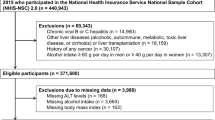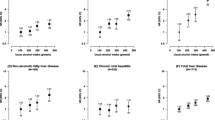Abstract
Aim
We aimed to investigate the combined impact of liver enzymes and alcohol consumption on the diabetes risk.
Methods
Data on 5972 non-diabetic participants aged 30–79 years from the Suita study were analyzed. Diabetes incidence was surveyed every 2 years. Current daily alcohol consumption was defined as light drinking (< 23.0 g ethanol/day in men and < 11.5 g in women), moderate drinking (23.0–45.9 g and 11.5–22.9 g), and heavy drinking (≥ 46.0 g and ≥ 23.0 g). The nondrinkers category included both never-drinkers and former drinkers.
Results
During the median follow-up of 13 years, 597 incident diabetes cases were diagnosed. Higher levels of γ-glutamyltransferase (GGT), alanine aminotransferase (GPT), and aspartate aminotransferase (GOT) were associated with an increased diabetes risk, and current light drinkers had a lower risk of diabetes than nondrinkers. No sex differences were observed in these associations. Compared to nondrinkers having the lowest quartiles of liver enzymes, nondrinkers and current moderate/heavy drinkers having the highest quartiles had an increased risk of diabetes. However, no association was observed for current light drinkers having the highest quartiles of liver enzymes; the multivariable hazard ratios (95% CIs) in current light drinkers with the highest quartile of liver enzymes were 1.27 (0.68–2.37) for GGT, 1.05 (0.59–1.89) for GPT, and 0.76 (0.40–1.47) for GOT, respectively.
Conclusion
High liver enzymes were associated with an increased diabetes risk. No increased diabetes risk was observed in current light drinkers, even in these who had high levels of liver enzymes.
Similar content being viewed by others
Availability of data and materials
Research data are not publicly available on legal or ethical grounds.
References
Vozarova B, Stefan N, Lindsay RS et al (2002) High alanine aminotransferase is associated with decreased liver insulin sensitivity and predicts the development of type 2 diabetes. Diabetes 51:1889–1895
Fraser A, Ebrahim S, Smith GD, Lawlor DA (2007) A comparison of associations of alanine aminotransferase and gamma-glutamyltransferase with fasting glucose, fasting insulin, and glycated hemoglobin in women with and without diabetes. Hepatology 46:158–165
Bonnet F, Ducluzeau PH, Gastaldelli A et al (2011) RISC Study Group Liver enzymes are associated with liver insulin resistance, insulin secretion, and glucagon concentration in healthy men and women. Diabetes 60:1660–1667
Fraser A, Harris R, Sattar N, Ebrahim S, Davey Smith G, Lawlor DA (2009) Alanine aminotransferase, gamma-glutamyltransferase, and incident diabetes: the British Women’s Heart and Health Study and meta-analysis. Diabetes Care 32:741–750
Kunutsor SK, Apekey TA, Walley J (2013) Liver aminotransferases and risk of incident type 2 diabetes: a systematic review and meta-analysis. Am J Epidemiol 178:159–171
De Silva NMG, Borges MC, Hingorani AD et al (2019) Liver function and risk of type 2 diabetes: bidirectional Mendelian randomization study. Diabetes 68:1681–1691
Kunutsor SK, Abbasi A, Apekey TA (2014) Aspartate aminotransferase: Risk marker for type-2 diabetes mellitus or red herring? Front Endocrinol 5:189
Lee YS, Cho Y, Burgess S et al (2016) Serum gamma-glutamyl transferase and risk of type 2 diabetes in the general Korean population: a Mendelian randomization study. Hum Mol Genet 25:3877–3886
Sato KK, Hayashi T, Nakamura Y et al (2008) Liver enzymes compared with alcohol consumption in predicting the risk of type 2 diabetes: the Kansai Healthcare Study. Diabetes Care 31:1230–1236
Agarwal S, Fulgoni VL III, Lieberman HR (2016) Assessing alcohol intake & its dose-dependent effects on liver enzymes by 24-h recall and questionnaire using NHANES 2001–2010 data. Nutr J 15:62
Baliunas DO, Taylor BJ, Irving H et al (2009) Alcohol as a risk factor for type 2 diabetes: a systematic review and meta-analysis. Diabetes Care 32:2123–2132
Kokubo Y, Okamura T, Watanabe M et al (2010) The combined impact of blood pressure category and glucose abnormality on the incidence of cardiovascular diseases in a japanese urban cohort: the Suita study. Hypertens Res 33:1238–1243
Kokubo Y, Watanabe M, Higashiyama A, Nakao YM, Nakamura F, Miyamoto Y (2018) Impact of intima-media thickness progression in the common carotid arteries on the risk of incident cardiovascular disease in the Suita study. J Am Heart Assoc 7:e007720
Li J, Kokubo Y, Arafa A, et al (2021) Mild hypertensive retinopathy and risk of cardiovascular disease: the Suita study. J Atheroscler Thromb. Epub ahead of print
Imai E, Horio M, Nitta K et al (2007) Estimation of glomerular filtration rate by the MDRD study equation modified for Japanese patients with chronic kidney disease. Clin Exp Nephrol 11:41–50
Marchesini G, Brizi M, Bianchi G et al (2001) Nonalcoholic fatty liver disease: a feature of the metabolic syndrome. Diabetes 50:1844–1850
Westerbacka J, Cornér A, Tiikkainen M et al (2004) Women and men have similar amounts of liver and intra-abdominal fat, despite more subcutaneous fat in women: implications for sex differences in markers of cardiovascular risk. Diabetologia 47:1360–1369
Ceriello A, Motz E (2004) Is oxidative stress the pathogenic mechanism underlying insulin resistance, diabetes, and cardiovascular disease? The common soil hypothesis revisited. Arterioscler Thromb Vasc Biol 24:816–823
Turgut O, Yilmaz A, Yalta K, Karadas F, Birhan YM (2006) Gamma-glutamyltransferase is a promising biomarker for cardiovascular risk. Med Hypotheses 67:1060–1064
Kim CH, Park JY, Lee KU, Kim JH, Kim HK (2009) Association of serum gamma-glutamyltransferase and alanine aminotransferase activities with risk of type 2 diabetes mellitus independent of fatty liver. Diabetes Metab Res Rev 25:64–69
Mayer EJ, Newman B, Quesenberry CP Jr, Friedman GD, Selby JV (1993) Alcohol consumption and insulin concentrations: role of insulin in associations of alcohol intake with high-density lipoprotein cholesterol and triglycerides. Circulation 88:2190–2197
Facchini F, Chen YD, Reaven GM (1994) Light-to-moderate alcohol intake is associated with enhanced insulin sensitivity. Diabetes Care 17:115–119
Kawasaki E, Matsuura N, Eguchi K (2006) Type 1 diabetes in Japan. Diabetologia 49:828–836
Acknowledgements
We would like to express our deepest gratitude to Drs. Kawanishi and Misaki, the former and current presidents of the Suita Medical Association, respectively, and to all the Suita City Health Center members and staff of Preventive Cardiology and Preventive Healthcare Departments for performing medical examinations and follow-ups. We also would like to express our special gratitude to Professor Hiroyasu Iso from Osaka University and all cohort members.
Funding
This study was supported by the Intramural Research Fund (20-4-9) for cardiovascular diseases of the National Cerebral and Cardiovascular Center, JST Grant Number JPMJPF2018, and by Health and Labour Sciences Research Grants of the Ministry of Health, Labour and Welfare of Japan (20FA1002). This study was also supported by the Meiji Yasuda Research Institute, Inc. and Meiji Yasuda Life Insurance Company.
Author information
Authors and Affiliations
Contributions
JL and YK contributed to initial concept; YK provided resources; YK acquired funding; JL and YK contributed to literature review; JL contributed to draft writing; JL analyzed the data; YK contributed to supervision; all authors contributed to critical revision.
Corresponding author
Ethics declarations
Conflict of interest
The authors declare that they have no competing interests.
Consent for publication
Informed consent was obtained from all study participants.
Ethics approval and consent to participate
The study protocol was approved by the Institutional Review Board of the National Cerebral and Cardiovascular Center, Osaka, Japan (R21024). The study was conducted per the Declaration of Helsinki. Written informed consent was obtained from all participants for their anonymized information in the Suita study.
Additional information
Managed By Antonio Secchi.
Publisher's Note
Springer Nature remains neutral with regard to jurisdictional claims in published maps and institutional affiliations.
Rights and permissions
Springer Nature or its licensor holds exclusive rights to this article under a publishing agreement with the author(s) or other rightsholder(s); author self-archiving of the accepted manuscript version of this article is solely governed by the terms of such publishing agreement and applicable law.
About this article
Cite this article
Li, J., Arafa, A., Kashima, R. et al. Liver enzymes, alcohol consumption and the risk of diabetes: the Suita study. Acta Diabetol 59, 1531–1537 (2022). https://doi.org/10.1007/s00592-022-01949-1
Received:
Accepted:
Published:
Issue Date:
DOI: https://doi.org/10.1007/s00592-022-01949-1




